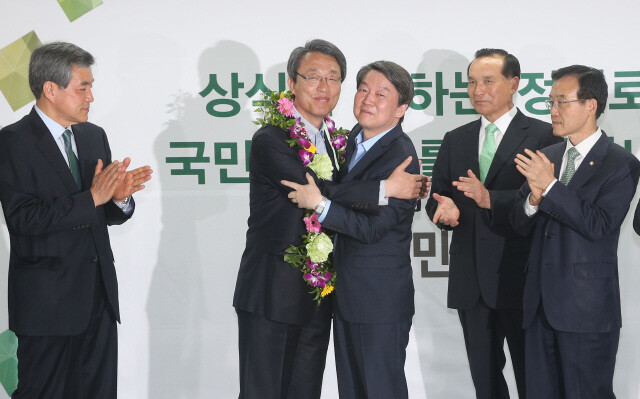hankyoreh
Links to other country sites 다른 나라 사이트 링크
[Editorial] People’s Party opens the way to a real three party system

One of the most important developments in South Korea’s general elections on Apr. 13 was the great success of the People‘s Party, leading to the first three-party system in 20 years.
The newly created People’s Party gained 38 seats in a short period of time and did quite well in the proportional voting, even edging out the main opposition Minjoo Party of Korea.
When party leader Ahn Cheol-soo left the Minjoo Party, it was unclear whether the third-party experiment would be successful, but the election makes clear that the new party received wide support.
This outcome shows that the idea of a third party that transcends the traditional divide between the Minjoo Party and the ruling Saenuri Party resonates strongly with a wide range of voters. According to exit polls by South Korea‘s three public broadcasters, the People’s Party did not only lure away voters from the Minjoo Party: 12.9% of voters who voted for Saenuri Party candidates in their election district chose the People‘s Party in proportional voting.
While this is not as much as the percentage of voters who supported a Minjoo Party candidate in their district and the People’s Party in the proportional voting (20.8%), it does show that the People‘s Party did not merely split the opposition vote. This effectively proved the argument that the People’s Party has expanded the opposition‘s base.
The emergence of a third party means that the Saenuri Party must face demands to push ahead with conservative reform, while the Minjoo Party confronts the need to transform itself into a party that offers reasonable alternatives.
The political clout of the People’s Party was further magnified by the fact that neither the Minjoo Party nor the Saenuri Party managed to gain a majority in the National Assembly. The Minjoo Party became the biggest party with 123 seats while the Saenuri Party was reduced to the second biggest party with 122 seats.
What is clear, though, is that the People‘s Party must adopt a definite course and vision instead of simply walking a tightrope between the two major parties. It must remember that the reason voters gave it so much support was not so that it could cast the deciding vote and create some kind of mechanical balance between the Saenuri Party and the Minjoo Party.
The public sentiment shown in this election can be summarized as a demand for the current administration to stop running the country in such a highhanded manner and for the National Assembly to take the reins and to run the country properly. For that to happen, it is not enough to treat the three-party system that has emerged for the first time in 20 years as a means to produce political bargaining and compromising. It must also become a way of paying attention to public demands and applying those demands to government action.
And the party that should feel the most responsible for that is the People’s Party.
Please direct questions or comments to [english@hani.co.kr]

Editorial・opinion
![[Column] Has Korea, too, crossed the Rubicon on China? [Column] Has Korea, too, crossed the Rubicon on China?](https://flexible.img.hani.co.kr/flexible/normal/500/300/imgdb/original/2024/0419/9317135153409185.jpg) [Column] Has Korea, too, crossed the Rubicon on China?
[Column] Has Korea, too, crossed the Rubicon on China?![[Correspondent’s column] In Japan’s alliance with US, echoes of its past alliances with UK [Correspondent’s column] In Japan’s alliance with US, echoes of its past alliances with UK](https://flexible.img.hani.co.kr/flexible/normal/500/300/imgdb/original/2024/0419/2317135166563519.jpg) [Correspondent’s column] In Japan’s alliance with US, echoes of its past alliances with UK
[Correspondent’s column] In Japan’s alliance with US, echoes of its past alliances with UK- [Editorial] Does Yoon think the Korean public is wrong?
- [Editorial] As it bolsters its alliance with US, Japan must be accountable for past
- [Guest essay] Amending the Constitution is Yoon’s key to leaving office in public’s good graces
- [Editorial] 10 years on, lessons of Sewol tragedy must never be forgotten
- [Column] A death blow to Korea’s prosecutor politics
- [Correspondent’s column] The US and the end of Japanese pacifism
- [Guest essay] How Korea turned its trainee doctors into monsters
- [Guest essay] As someone who helped forge Seoul-Moscow ties, their status today troubles me
Most viewed articles
- 1[Column] The clock is ticking for Korea’s first lady
- 2Samsung barricades office as unionized workers strike for better conditions
- 3After 2 months of delayed, denied medical care, Koreans worry worst may be yet to come
- 4[Correspondent’s column] In Japan’s alliance with US, echoes of its past alliances with UK
- 5[Column] Has Korea, too, crossed the Rubicon on China?
- 6Hong Se-hwa, voice for tolerance whose memoir of exile touched a chord, dies at 76
- 7[Editorial] When the choice is kids or career, Korea will never overcome birth rate woes
- 8Constitutional Court rules to disband left-wing Unified Progressive Party
- 9Nearly 1 in 5 N. Korean defectors say they regret coming to S. Korea
- 10‘Right direction’: After judgment day from voters, Yoon shrugs off calls for change